|
|
Post by oldgeek on Dec 10, 2015 0:41:23 GMT -5
As told in another thread, I picked up a non running 2005 Kymco ZX50 Super Fever II scooter earlier this year. I got it running fairly easy, and put a Taiwan 47mm BBK, V8 Pipe, Stage6 intake and a 19mm Dell clone. I enjoyed riding it until the crank bearings got loud so I parked it. The ZX50 uses a Kymco SC10 motor that is a partial clone of Hondas AF16 2 stroke motor. The major difference between the two motors that I have found so far is the gearbox. The SC10's gearbox is totally different from the AF16. Also the SC10 motor is a bit longer allowing you to fit 12" wheels. Otherwise they share the same type of crank, cylinder, intake and exhaust fittings. I am not sure if the motor mounts are the same yet, but I will eventually find out. By chance I picked up a used 2003 SC10 motor on FeeBay for a decent price. My plan is a decent build of this motor and to put it on the ZX50. I tore the motor down to find that the PO had split the cases at some point and hacked the motor up a bit, ruining the crank, and scarring up the cases, but it should be repairable. I have picked up some decent parts over time for this build. Malossi RHQ crank Polini Corsa cylinder Phongeer short pipe Stage 6 intake and reedblock assembly Dellorto 21mm carb Oil pump delete plug So far I have cleaned up the sealing surfaces of the cases where the PO did his dirty deeds, enlarged the intake ports and windows a bit, and matched the Polini cylinder transfers up to the cases. I am almost ready to start assembly but I wanted to post some pictures of the intake for opinion. The stock reedblock and intake appear to be smallish, but they are really close in proximity to the intake ports. The Polini Corsa kit comes with a CF reed to replace the stock metal one. On the other hand the Stage6 intake is way different and uses a much larger reed block at the expense of moving the reed block away from the intake ports a little. Also the Stage 6 does not come with a stuffer for the reed block, whereas the stock reedblock sort of has a stuffer built in. I wonder which setup is really better? 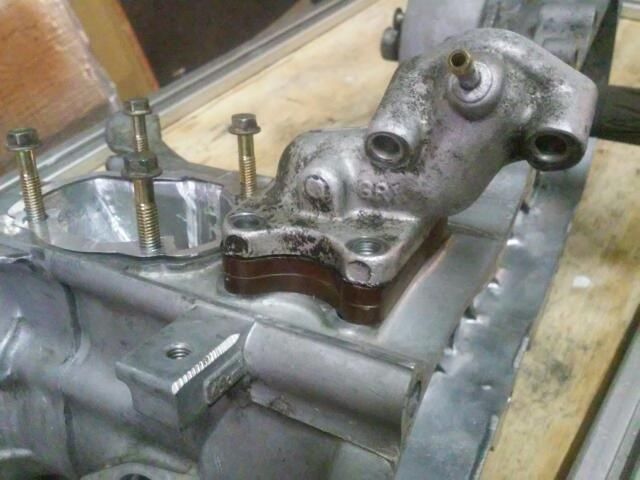 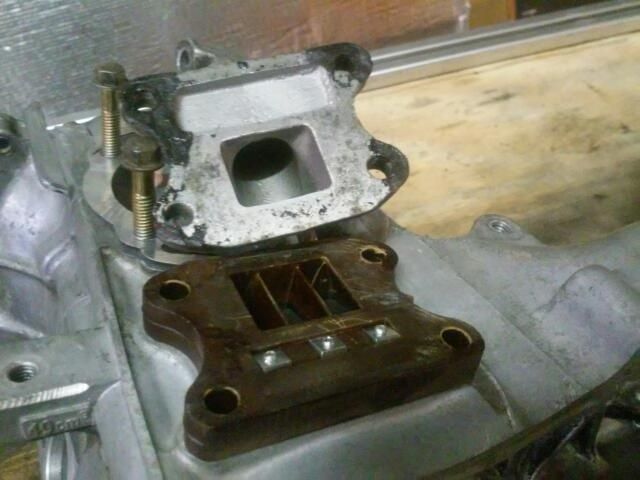 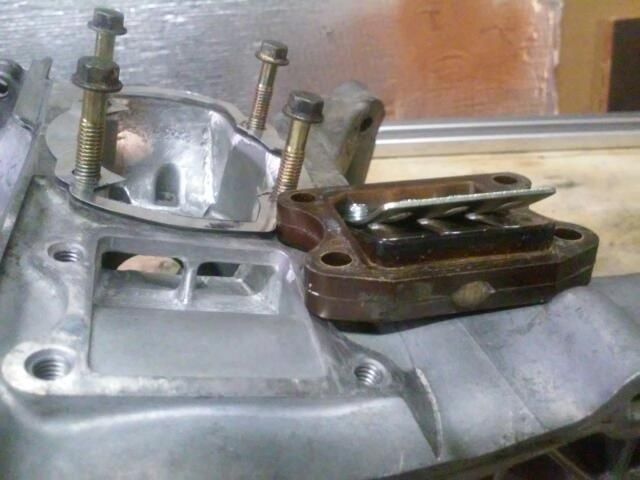 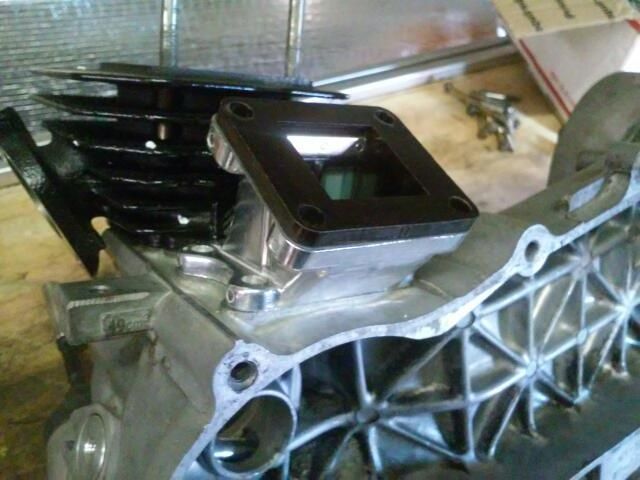 |
|
|
|
Post by 190mech on Dec 10, 2015 6:32:56 GMT -5
Lookin Good!!  |
|
|
|
Post by oldgeek on Dec 10, 2015 8:04:53 GMT -5
While looking this motor over I noticed this little channel and hole. I assume it provides lubrication to the oil pump shaft and gear area. Since I will not be using the oil pump, I decided to fill the hole and channel with epoxy. I under cut the sides of the channel a bit so the epoxy would hopefully get locked in place. 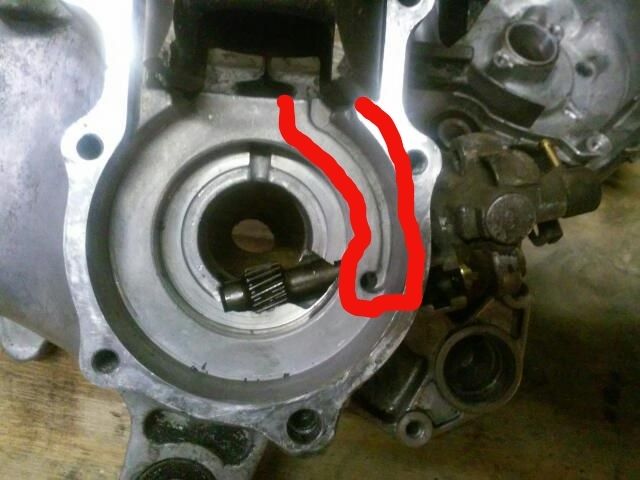 Here are pictures of the oil pump delete plug. 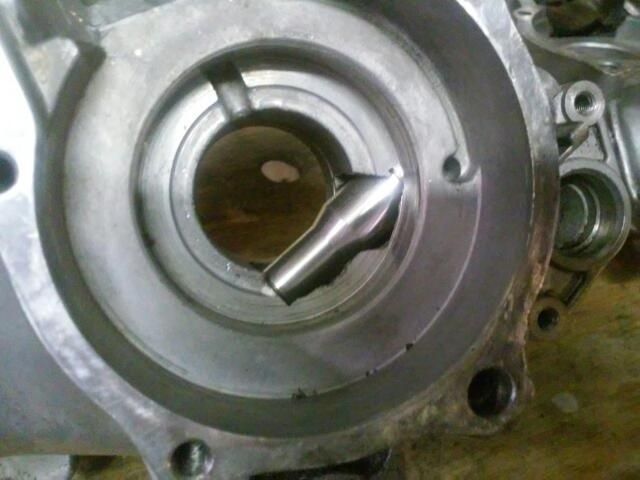 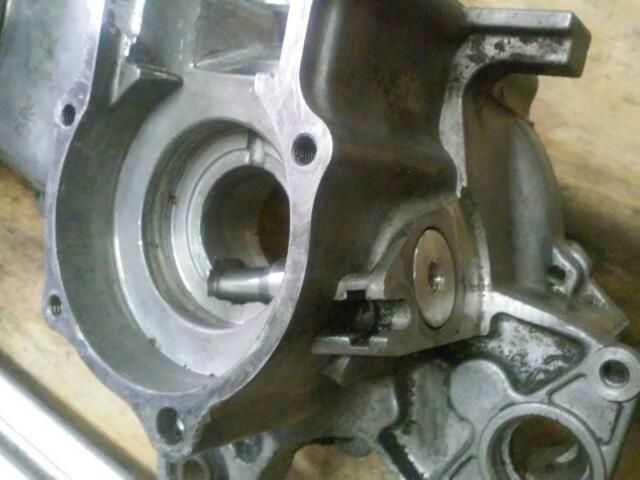 |
|
|
|
Post by Corrosion on Dec 10, 2015 8:39:11 GMT -5
I have a spare motor, crankshaft,cylinder-is rusty,clutch & variator- rusty. Honda- AF-05E. Looks similar.
If you want any of it its yours. It is apart ATM, my kid has been steeling hardware off it, for years. so all the bolts are gone. Crank was pulled with a splitter, so should be in decent shape.
|
|
|
|
Post by cwazywazy on Dec 10, 2015 8:48:48 GMT -5
Just wondering, what's the purpose of deleting the oil pump?
|
|
|
|
Post by Corrosion on Dec 10, 2015 9:05:13 GMT -5
eliminating chance of lubrication failure, drag. Precise oil ratio. ECT.
|
|
|
|
Post by ryan_ott on Dec 10, 2015 9:36:39 GMT -5
They are just a worm gear with a seal and are kind of known to leak lots of oil in the motor. When I was using the oil pump It would have enormous amount of smoke on start up. I'm premix now.
|
|
|
|
Post by cwazywazy on Dec 10, 2015 9:38:26 GMT -5
They are just a worm gear with a seal and are kind of known to leak lots of oil in the motor. When I was using the oil pump It would have enormous amount of smoke on start up. I'm premix now. Oh, right. I forgot about premixing and all that. |
|
|
|
Post by 90GTVert on Dec 10, 2015 10:43:34 GMT -5
Thanks for all fo the pics/info so far.
I'd probably end up trying both intake systems. I usually find it's more effective to swap them and see what happens than to guess, but that may just be my lack of deep understanding of everything at play.
A couple of things to think about would be the size of the stock intake. Does it match up well to the size of the carb or is it too small? What kind of flow area do you have from the stock reeds? Does it match up to the area of the stock intake and carb? Also, how bad that stock intake pinches in the turns. It looks like you have a series of twists/turns in the stock piece. There's some info in the end of chapter 3 of Bell's 2T book.
|
|
|
|
Post by ryan_ott on Dec 10, 2015 17:20:29 GMT -5
I think you would be ok using the stage6 intake. You lose some primary compression because of its design but using the rhq crank which is a full circle would raise it. You probably maintain original pcr or raise it slightly. Plus should be easier to adapt for carb size. Your making me want to split mine and port the intake port.
|
|
|
|
Post by oldgeek on Dec 10, 2015 18:42:06 GMT -5
I have a spare motor, crankshaft,cylinder-is rusty,clutch & variator- rusty. Honda- AF-05E. Looks similar. If you want any of it its yours. It is apart ATM, my kid has been steeling hardware off it, for years. so all the bolts are gone. Crank was pulled with a splitter, so should be in decent shape. Thanks for the offer but I dont think the motor is the same. I have a spree with an AF-05E motor on it. The whole scooter looks like it was in a flood. If I ever try to revive that mess, I will take you up on your offer if you still have it. |
|
|
|
Post by oldgeek on Dec 10, 2015 19:43:49 GMT -5
Thanks for all fo the pics/info so far. I'd probably end up trying both intake systems. I usually find it's more effective to swap them and see what happens than to guess, but that may just be my lack of deep understanding of everything at play. A couple of things to think about would be the size of the stock intake. Does it match up well to the size of the carb or is it too small? What kind of flow area do you have from the stock reeds? Does it match up to the area of the stock intake and carb? Also, how bad that stock intake pinches in the turns. It looks like you have a series of twists/turns in the stock piece. There's some info in the end of chapter 3 of Bell's 2T book. I forgot to mention that I also installed the Stage6 intake and a 19mm Dell or clone carb on the Kymco when I did the BBK. The whole setup pulled real well, and was almost as fast as my Streetrace setup. The stock intake has a flange for the carb connection, I would have to get one of the adapters I saw somewhere that will let you bolt up a Dell style carb to the stock intake. It also looks like you could open the intake so it will flow a bit better. IMO visually the intake port windows surface area appears similar to the surface area of the stock reed block. Like you say, only way to know for sure is to try both. I will likely just reuse the Stage6 intake since it seemed to work good. I think you would be ok using the stage6 intake. You lose some primary compression because of its design but using the rhq crank which is a full circle would raise it. You probably maintain original pcr or raise it slightly. Plus should be easier to adapt for carb size. Your making me want to split mine and port the intake port. See above. I hear the term Primary compression here and there, but I really have no idea what role it plays, or how much you need for a particular build. Is more always better? |
|
|
|
Post by tiny on Dec 11, 2015 22:04:29 GMT -5
Your making me miss my Elite. Now stop it.
(just kidding keep it coming Mate)
|
|
|
|
Post by Lucass2T on Dec 12, 2015 6:56:55 GMT -5
See above. I hear the term Primary compression here and there, but I really have no idea what role it plays, or how much you need for a particular build. Is more always better? It's quite difficult since it has effect on a lot of things. I couldn't really explain but Bell wrote a couple a pages about it. |
|
|
|
Post by 90GTVert on Dec 12, 2015 8:57:03 GMT -5
Some of the idea is that increasing primary/crankcase compression can create higher port velocities and move more mixture than low velocities in the same time period. Too much can push mixture out through the exhaust port. The more compression, above or below the piston for that matter, the more heat you'll create and the greater the pumping losses will be because the engine has to work against that compressed mixture. Too much or too little can have negative effects on power, but I really have no idea what's considered a good PCR. Most of us do whatever we can to increase flow and don't put a lot of thought into actual PCR. Honestly from running stuffer and non-stuffer cranks with the same cylinder, I couldn't really tell a difference. That's not exactly scientific. I'm certain it makes some difference if it's all setup right, but mild changes here and there haven't done anything obvious for me. Maybe if you know all of the details or buy a $500 2T engine simulation program you could dial it all in to the tee, but I never recall seeing anyone talk about any ideal figures on the forum over the years. IIRC from what I've picked up from 190mech, thoughts on PCR have changed since older writings and with newer pipes. Bring up your browser's search function and you can find primary compression info from Jennings pretty quickly here : www.datafan.com/Horsepower_Blog/gordon-jennings-two-stroke-tuners-handbook/ |
|

















